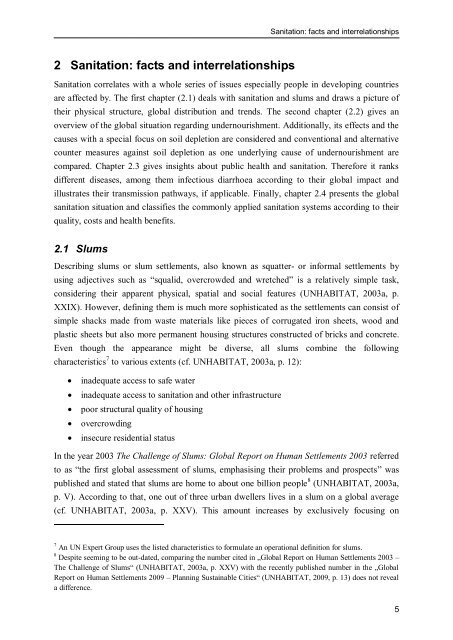Economic Effects of Sustainable Sanitation - SuSanA
Economic Effects of Sustainable Sanitation - SuSanA
Economic Effects of Sustainable Sanitation - SuSanA
You also want an ePaper? Increase the reach of your titles
YUMPU automatically turns print PDFs into web optimized ePapers that Google loves.
2 <strong>Sanitation</strong>: facts and interrelationships<br />
<strong>Sanitation</strong>: facts and interrelationships<br />
<strong>Sanitation</strong> correlates with a whole series <strong>of</strong> issues especially people in developing countries<br />
are affected by. The first chapter (2.1) deals with sanitation and slums and draws a picture <strong>of</strong><br />
their physical structure, global distribution and trends. The second chapter (2.2) gives an<br />
overview <strong>of</strong> the global situation regarding undernourishment. Additionally, its effects and the<br />
causes with a special focus on soil depletion are considered and conventional and alternative<br />
counter measures against soil depletion as one underlying cause <strong>of</strong> undernourishment are<br />
compared. Chapter 2.3 gives insights about public health and sanitation. Therefore it ranks<br />
different diseases, among them infectious diarrhoea according to their global impact and<br />
illustrates their transmission pathways, if applicable. Finally, chapter 2.4 presents the global<br />
sanitation situation and classifies the commonly applied sanitation systems according to their<br />
quality, costs and health benefits.<br />
2.1 Slums<br />
Describing slums or slum settlements, also known as squatter- or informal settlements by<br />
using adjectives such as ―squalid, overcrowded and wretched‖ is a relatively simple task,<br />
considering their apparent physical, spatial and social features (UNHABITAT, 2003a, p.<br />
XXIX). However, defining them is much more sophisticated as the settlements can consist <strong>of</strong><br />
simple shacks made from waste materials like pieces <strong>of</strong> corrugated iron sheets, wood and<br />
plastic sheets but also more permanent housing structures constructed <strong>of</strong> bricks and concrete.<br />
Even though the appearance might be diverse, all slums combine the following<br />
characteristics 7 to various extents (cf. UNHABITAT, 2003a, p. 12):<br />
inadequate access to safe water<br />
inadequate access to sanitation and other infrastructure<br />
poor structural quality <strong>of</strong> housing<br />
overcrowding<br />
insecure residential status<br />
In the year 2003 The Challenge <strong>of</strong> Slums: Global Report on Human Settlements 2003 referred<br />
to as ―the first global assessment <strong>of</strong> slums, emphasising their problems and prospects‖ was<br />
published and stated that slums are home to about one billion people 8 (UNHABITAT, 2003a,<br />
p. V). According to that, one out <strong>of</strong> three urban dwellers lives in a slum on a global average<br />
(cf. UNHABITAT, 2003a, p. XXV). This amount increases by exclusively focusing on<br />
7 An UN Expert Group uses the listed characteristics to formulate an operational definition for slums.<br />
8 Despite seeming to be out-dated, comparing the number cited in „Global Report on Human Settlements 2003 –<br />
The Challenge <strong>of</strong> Slums― (UNHABITAT, 2003a, p. XXV) with the recently published number in the „Global<br />
Report on Human Settlements 2009 – Planning <strong>Sustainable</strong> Cities― (UNHABITAT, 2009, p. 13) does not reveal<br />
a difference.<br />
5

















